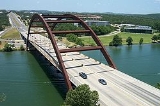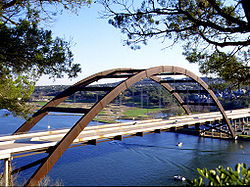
Pennybacker Bridge
Encyclopedia
The Pennybacker Bridge in Austin, Texas
bridge
s Lake Austin
to connect north and south Loop 360 highway, also known as the "Capital of Texas Highway." The road is widely considered one of the most scenic urban drives in central Texas, in large part due to this arched weathering steel bridge and the rolling hills that flank the road. In 2001, 48,000 vehicles crossed the bridge daily. Ten years prior, 22,000 vehicles crossed the bridge daily.
and other public officials and opened for traffic December 3, 1982.
The bridge is named for Percy Pennybacker
, who designed bridges for the Texas Highway Department and was a pioneer in the technology of welded structures.
 The steel bridge has a uniform weathered rust finish allowing the bridge to blend in with the surrounding hills and lake. The 600000000 pounds (272,155,422 kg) of steel for the bridge were produced in Japan
The steel bridge has a uniform weathered rust finish allowing the bridge to blend in with the surrounding hills and lake. The 600000000 pounds (272,155,422 kg) of steel for the bridge were produced in Japan
. The bridge structures were fabricated in Ulsan
, Korea
by Hyundai Heavy Industries
. The steel structures were shipped on the Jundale freighter to the Port of Houston
and then trucked to the bridge site. The bridge was erected by Bristol Steel of Bristol, Virginia
. The roadway surface is built from 3400 short tons (3,084,428.1 kg) of concrete
. The finish was sandblasted to ensure even weathering for an amber patina
. The construction was coordinated by Clearwater Constructors of Denver, Colorado
. Ed Westall was the project coordinator, Buddy Johnson was the project supervisor and David McDonnold was the bridge designing engineer. The bridge cost US$
10 million to build.
The bridge is constructed such that no part of the structure touches the water
100 feet (30 m) below. The bridge is 1150 feet (351 m) long with a 600 feet (183 m) central arched span. This design keeps Lake Austin free from support columns because the recreational lake (really a dammed stretch of the Colorado River
) is popular with boaters and waterskiers. The untied arch suspension span is suspended by 72 steel cables. At the time of its construction, it was only the second bridge of its design in the world.
 The bridge has four lanes, two in each direction, separated by a middle barrier wall. The bridge also has a 6 feet (1.8 m) bike and pedestrian lane. The bike access on the bridge is one reason for Loop 360's popularity with cyclists. The south approach provides a turnaround under the bridge along with lake access for public boating.
The bridge has four lanes, two in each direction, separated by a middle barrier wall. The bridge also has a 6 feet (1.8 m) bike and pedestrian lane. The bike access on the bridge is one reason for Loop 360's popularity with cyclists. The south approach provides a turnaround under the bridge along with lake access for public boating.
The bridge won first place in the 1984 Federal Highway Administration's Excellence in Highway Design competition. In 1992, the Austin members of the Consulting Engineers Council of Texas were surveyed and selected the bridge as the most innovative example of Austin architecture.

Austin, Texas
Austin is the capital city of the U.S. state of :Texas and the seat of Travis County. Located in Central Texas on the eastern edge of the American Southwest, it is the fourth-largest city in Texas and the 14th most populous city in the United States. It was the third-fastest-growing large city in...
bridge
Bridge
A bridge is a structure built to span physical obstacles such as a body of water, valley, or road, for the purpose of providing passage over the obstacle...
s Lake Austin
Lake Austin
Lake Austin is a reservoir on the Colorado River in Austin, Texas in the United States. The reservoir was formed in 1939 by the construction of Tom Miller Dam by the Lower Colorado River Authority....
to connect north and south Loop 360 highway, also known as the "Capital of Texas Highway." The road is widely considered one of the most scenic urban drives in central Texas, in large part due to this arched weathering steel bridge and the rolling hills that flank the road. In 2001, 48,000 vehicles crossed the bridge daily. Ten years prior, 22,000 vehicles crossed the bridge daily.
History
More commonly known as the "360 Bridge," the contract for the bridge was let in late 1979 and major structural steelwork was finished by July 1982. The bridge was dedicated officially November 29, 1982 by Austin mayor Carole McClellanCarole Keeton Strayhorn
Carole Keeton Strayhorn is the former Texas Comptroller of Public Accounts....
and other public officials and opened for traffic December 3, 1982.
The bridge is named for Percy Pennybacker
Percy Pennybacker
Percy V. Pennybacker was a Texas civil engineer who pioneered the technology of welded structures, particularly for bridges.-Professional success:...
, who designed bridges for the Texas Highway Department and was a pioneer in the technology of welded structures.
Construction details

Japan
Japan is an island nation in East Asia. Located in the Pacific Ocean, it lies to the east of the Sea of Japan, China, North Korea, South Korea and Russia, stretching from the Sea of Okhotsk in the north to the East China Sea and Taiwan in the south...
. The bridge structures were fabricated in Ulsan
Ulsan
Ulsan , officially the Ulsan Metropolitan City, is South Korea's seventh largest metropolis with a population of over 1.1 million. It is located in the south-east of the country, neighboring Busan to the south and facing Gyeongju to the north and the Sea of Japan to the east.Ulsan is the...
, Korea
Korea
Korea ) is an East Asian geographic region that is currently divided into two separate sovereign states — North Korea and South Korea. Located on the Korean Peninsula, Korea is bordered by the People's Republic of China to the northwest, Russia to the northeast, and is separated from Japan to the...
by Hyundai Heavy Industries
Hyundai Heavy Industries
Hyundai Heavy Industries Co., Ltd. is the world's largest shipbuilding company, headquartered in Ulsan, South Korea. The company is a subsidiary of Hyundai Heavy Industries Group...
. The steel structures were shipped on the Jundale freighter to the Port of Houston
Port of Houston
The Port of Houston is a port in Houston—the fourth-largest city in the United States. The Port is a 25-mile-long complex of diversified public and private facilities located a few hours' sailing time from the Gulf of Mexico...
and then trucked to the bridge site. The bridge was erected by Bristol Steel of Bristol, Virginia
Bristol, Virginia
Bristol is an independent city in Virginia, United States, bounded by Washington County, Virginia, Bristol, Tennessee, and Sullivan County, Tennessee....
. The roadway surface is built from 3400 short tons (3,084,428.1 kg) of concrete
Concrete
Concrete is a composite construction material, composed of cement and other cementitious materials such as fly ash and slag cement, aggregate , water and chemical admixtures.The word concrete comes from the Latin word...
. The finish was sandblasted to ensure even weathering for an amber patina
Patina
Patina is a tarnish that forms on the surface of bronze and similar metals ; a sheen on wooden furniture produced by age, wear, and polishing; or any such acquired change of a surface through age and exposure...
. The construction was coordinated by Clearwater Constructors of Denver, Colorado
Denver, Colorado
The City and County of Denver is the capital and the most populous city of the U.S. state of Colorado. Denver is a consolidated city-county, located in the South Platte River Valley on the western edge of the High Plains just east of the Front Range of the Rocky Mountains...
. Ed Westall was the project coordinator, Buddy Johnson was the project supervisor and David McDonnold was the bridge designing engineer. The bridge cost US$
United States dollar
The United States dollar , also referred to as the American dollar, is the official currency of the United States of America. It is divided into 100 smaller units called cents or pennies....
10 million to build.
The bridge is constructed such that no part of the structure touches the water
Water
Water is a chemical substance with the chemical formula H2O. A water molecule contains one oxygen and two hydrogen atoms connected by covalent bonds. Water is a liquid at ambient conditions, but it often co-exists on Earth with its solid state, ice, and gaseous state . Water also exists in a...
100 feet (30 m) below. The bridge is 1150 feet (351 m) long with a 600 feet (183 m) central arched span. This design keeps Lake Austin free from support columns because the recreational lake (really a dammed stretch of the Colorado River
Colorado River (Texas)
The Colorado River is a river that runs through the U.S. state of Texas; it should not be confused with the much longer Colorado River which flows from Colorado into the Gulf of California....
) is popular with boaters and waterskiers. The untied arch suspension span is suspended by 72 steel cables. At the time of its construction, it was only the second bridge of its design in the world.

The bridge won first place in the 1984 Federal Highway Administration's Excellence in Highway Design competition. In 1992, the Austin members of the Consulting Engineers Council of Texas were surveyed and selected the bridge as the most innovative example of Austin architecture.
See also
External links


